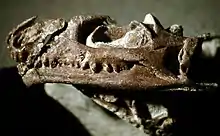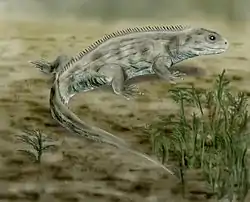Opisthias
Opisthias is a genus of sphenodont reptile. The type species, Opisthias rarus, is known from the Late Jurassic Morrison Formation of western North America,[2] present in stratigraphic zones 2 and 4–6.[3] A lower jaw is also known from the Berriasian aged Lulworth Formation of the United Kingdom, which appears to be distinct from the type North American species.[4] Other remains are also known from the Late Jurassic of Portugal.[5]
| Opisthias | |
|---|---|
 | |
| Skull from Dinosaur National Monument | |
| Scientific classification | |
| Kingdom: | Animalia |
| Phylum: | Chordata |
| Class: | Reptilia |
| Order: | Rhynchocephalia |
| Clade: | †Opisthodontia |
| Genus: | †Opisthias Gilmore 1909 |
| Type species | |
| Opisthias rarus Gilmore, 1905[1] | |
Distribution
Opisthias was from the United States (Colorado, Utah, and Wyoming).,[1] as well as in southern England and Portugal.
Diet
Opisthias has been interpreted as a generalist, with its tooth morphology indicating had an ability to process plant material.[6]
References
- "Opisthias Gilmore 1909 (rhynchocephalian)". Paleobiology Database.
- Foster J (2007). "Table 2.1: Fossil Vertebrates of the Morrison Formation.". Jurassic West: The Dinosaurs of the Morrison Formation and Their World. Indiana University Press. pp. 58–59.
- Foster J (2007). "Appendix". Jurassic West: The Dinosaurs of the Morrison Formation and Their World. Indiana University Press. pp. 327–329.
- Herrera-Flores J (2020). Randall C (ed.). "New insights on an enigmatic sphenodontian jaw from Dorset". Proceedings of the Dorset Natural History and Archaeological Society. 141: 41–43.
- Herrera-Flores JA, Stubbs TL (July 2018). "A re-evaluation of the taxonomy and diversity of the Late Jurassic sphenodontian Opisthias rarus Gilmore 1909 (Lepidosauria: Rhynchocephalia)[oral presentation]" (PDF). 13th Symposium on Mesozoic Terrestrial Ecosystems and Biota.
- Apesteguía S, Gómez RO, Rougier GW (October 2014). "The youngest South American rhynchocephalian, a survivor of the K/Pg extinction". Proceedings. Biological Sciences. 281 (1792): 20140811. doi:10.1098/rspb.2014.0811. PMC 4150314. PMID 25143041.
This article is issued from Wikipedia. The text is licensed under Creative Commons - Attribution - Sharealike. Additional terms may apply for the media files.

